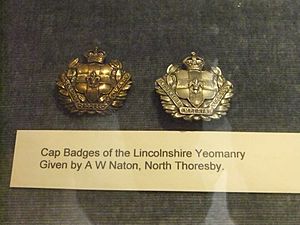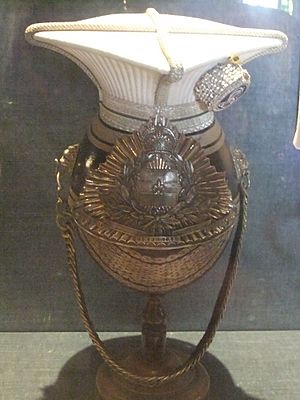Lincolnshire Yeomanry facts for kids
Quick facts for kids Lincolnshire Yeomanry |
|
|---|---|

Badges of the Lincolnshire Imperial Yeomanry, c1900
|
|
| Active | 1794–1920 |
| Country | |
| Branch | |
| Type | Yeomanry |
| Size | Maximum three Regiments in World War I |
| Engagements | South Africa 1900–1902 World War I Second Battle of Gaza Third Battle of Gaza Battle of Beersheba |
The Lincolnshire Yeomanry was a special volunteer cavalry unit in the British Army. It was first formed in 1794. This unit fought in the Second Boer War and the First World War. It was officially ended, or disbanded, in 1920.
History of the Lincolnshire Yeomanry
How the Yeomanry began
In 1793, the Prime Minister, William Pitt the Younger, had an idea. He suggested that counties in England should create volunteer cavalry units. These units, called Yeomanry Cavalry, would help defend the country. They could be called upon by the King to stop invasions. They could also help local leaders keep peace if there was trouble.
In 1794, several small volunteer groups started in Lincolnshire. However, these groups were disbanded in 1828. The Yeomanry in Lincolnshire was started again in 1831. It was called the North Lincoln Regiment of Yeomanry Cavalry. But this unit was also disbanded in 1846.
Fighting in the Second Boer War
On December 13, 1899, a big decision was made. Volunteer soldiers were allowed to fight in the Second Boer War in South Africa. The British government realized they needed more soldiers. This was because they had suffered some defeats in December 1899.
So, on December 24, 1899, a special order was issued. This order created the Imperial Yeomanry. Existing Yeomanry regiments were asked to provide companies of about 115 men each. Many British citizens volunteered to join. They were mostly from the middle and upper classes.
Even though there were strict rules, many volunteers were accepted. Some were not great at riding horses or shooting at first. But they had time to train while waiting to travel. The first group of new soldiers arrived in South Africa between February and April 1900. There were 550 officers and 10,371 men.
The idea of using mounted infantry (soldiers who ride horses but fight on foot) worked well. So, the existing Yeomanry regiments in Britain became Imperial Yeomanry. New regiments were also formed. The Lincolnshire Imperial Yeomanry was created on June 25, 1901. Its base was at the "old barracks" in Lincoln. In 1908, the word 'Imperial' was removed from their name. This happened when they joined the Territorial Force.
The First World War and the Yeomanry
The Territorial Force was created to defend Britain during wartime. Its members were not forced to fight outside the country. But when war started on August 4, 1914, many volunteered to serve overseas.
Because of this, the Territorial Force units were split. This happened in August and September 1914. There were "1st Line" units for overseas service. And "2nd Line" units for home service. A "3rd Line" was formed later. This line trained new soldiers to replace those fighting.
1st Line: 1/1st Lincolnshire Yeomanry
This regiment was called to action in August 1914. It was part of the North Midland Mounted Brigade. In September, it joined the 1st Mounted Division.
In 1915, they were ordered to go overseas. They were supposed to go to Salonika. But on the way, they were told to go to Egypt instead. In April 1916, their brigade was renamed the 22nd Mounted Brigade. It was part of the Western Frontier Force.
In early 1917, they moved to the ANZAC Mounted Division. They fought in the Second Battle of Gaza. In June 1917, they moved again. This time they joined the Yeomanry Mounted Division. They took part in the Third Battle of Gaza and the Battle of Beersheba. Later, this division was renamed the 1st Mounted Division. Then it became the 4th Cavalry Division. While with the 4th Cavalry Division, their brigade changed its name again. It became the 12th Cavalry Brigade.
In April 1918, the regiment left its brigade and its horses. They became a unit of the Machine Gun Corps that fought on foot. They joined with the 1/1st East Riding of Yorkshire Yeomanry. Together, they formed "D" Battalion, Machine Gun Corps. As the 102nd MGC, they moved to France in June 1918. They were attached to the First Army.
2nd Line: 2/1st Lincolnshire Yeomanry
The 2nd Line regiment was formed in 1914. In 1915, it joined the 2/1st North Midland Mounted Brigade. In October, this brigade joined the 1st Mounted Division in Norfolk. It took the place of the 1st Line brigade. On March 31, 1916, all remaining Mounted Brigades were numbered. Their brigade became the 3rd Mounted Brigade.
In July 1916, many 2nd Line Yeomanry units in the UK were reorganized. Most were changed into cyclist units. So, this regiment stopped using horses. It joined the 3rd Cyclist Brigade near Holt. The division they were in became the 1st Cyclist Division.
Another change happened in November 1916. The regiment got horses again. Their brigade was renamed the new 2nd Mounted Brigade. It was part of the new 1st Mounted Division at Bishop's Stortford. By May 1917, they were at Leybourne in Kent. The regiment became cyclists again in August 1917. They joined the 12th Cyclist Brigade in The Cyclist Division. By late 1917, they were in Tonbridge. In early 1918, they moved to Canterbury, where they stayed until the war ended.
3rd Line: 3/1st Lincolnshire Yeomanry
The 3rd Line regiment was formed in 1915. In the summer, it was linked to a Reserve Cavalry Regiment at Aldershot. In the summer of 1916, it was attached to the 12th Reserve Cavalry Regiment, also at Aldershot. In early 1917, it became part of the 1st Reserve Cavalry Regiment at The Curragh.
After the First World War
After the war, the Territorial Army was reformed. The 14 oldest Yeomanry Regiments stayed as cavalry units with horses. Other Yeomanry Regiments were changed into Royal Artillery Regiments. The Lincolnshire Yeomanry decided they did not want to become an artillery unit. So, the regiment was disbanded in 1920.
Regimental Museum
You can see collections about the Royal Lincolnshire Regiment and the Lincolnshire Yeomanry. They are on display at Lincoln's Museum of Lincolnshire Life.
Uniforms of the Yeomanry
The Lincolnshire Yeomanry existed for a relatively short time (1901-1920). They were known for their special "Lincoln green" uniforms. This color was a lighter shade of green than the dark "rifle green" worn by many in the British Army.
At first, their uniform was a simple khaki serge. But it had collars, shoulder straps, and cuff piping in Lincoln-green. Later, officers wore fancy lancer-style full dress uniforms. These included white fronts and hats with plumes called czapka caps. Other soldiers wore Lincoln-green "frock" tunics with peaked caps. They also had shoulder chains and double white stripes on their trousers. From about 1908 to 1920, they wore the standard khaki service uniform for training.
See also
- Imperial Yeomanry
- List of Yeomanry Regiments 1908
- Yeomanry
- Yeomanry order of precedence
- British yeomanry during the First World War
- Second line yeomanry regiments of the British Army


